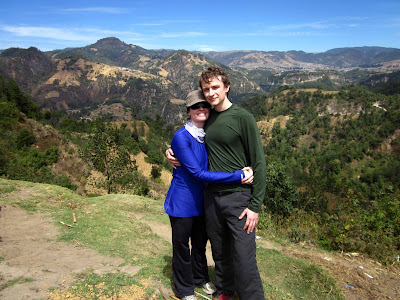We were asked the question so often that we had to stop to consider it ourselves: "Why did you decide to go (or come) to Guatemala?"
While there's no definite answer, when you consider all the factors that come into play while visiting a foreign country, it's easy to respond with an equally ambiguous "Why not Guatemala?"
Thus far in our lives, we haven't exactly selected the traditionally sunny, romantic or heavily touristed vacation destinations. Our interests don't lie on sunny beaches and tiki bars nor upon aged white-washed walls overlooking sunset seas and rustling vineyards. We can't say that the Statue of Liberty or the Eiffel Tower occupy must-see spots on our travel lists, although we by no means shirk the idea of traveling to such places.
So, why Guatemala?
Guatemala is a country whose colonial history extends further back than that of the United States, and its Mayan history far precedes that of much of Western Europe. Like much of Latin America, it has endured a troubled colonial past and these centuries-old tensions remain apparent in much of the culture: Spanish is the official language, the government administration and bureaucracies are identifiably Spanish and the major cities have distinctive Spanish architecture. And yet a vast majority of the population are of pure, native Mayan descent and the true character of the country isn't its Spanish influence but the underlying - and still very much alive -Mayan culture.
If you're having trouble grasping why two people from Minnesota would be fascinated by a country torn between a native people and colonists, there are simpler reasons for visiting Guatemala other than its history:
- Guatemala is a geological marvel. Massive rolling hills encapsulate cloud forests and allow several micro-climates to exist within miles of each other. You can't swing a dead cat without hitting a volcano (active or dormant) and deep lakes that foster and breathe life into much of the countryside are pocketed throughout the landscape as a result of its continuous volcanic eruptions and intermittent earthquakes.
- Guatemala has ancient ruins. As far as ruins go, Guatemala has by far the most to offer the tourist who is interested in the Maya. In addition to Tikal (hands down the most impressive Mayan city that still stands), Guatemala is sprinkled with countless ruins. While Mexico and Honduras are also home to Mayan ruins, Guatemala has not only the majority but also the most historically significant ones.
- Guatemala is warm. Immediately this appeals to snow-stricken northerners like ourselves. While winter continues to plod on in Minnesota, Guatemala is in its dry season or el verano (summertime) at this time of year. As a result of its tropical geography, Guatemala is often referred to as the mecca of tropical fruit by numerous travelers. Every city of significant size offers open air markets where locals sell an array of fruits - some familiar, such as strawberries, bananas, pineapple and mangoes, and some not so familiar, such as jocotes. While bartering for fruit in a busy market may not be the same relaxing atmosphere as sipping a piña colada on a beach, it does offer a lot more in the way of variety and freshness!
- Guatemala is friendly and a great place to work on your Spanish. Forget what you've heard about Guatemala's reputation. Yes, there is violence, however, it has an emerging tourism industry and most locals in places like Antigua and Xela are quite accommodating of tourists who approach them respectfully. Spanish helps, but is not truly required. The Spanish spoken in Guatemala is quite clear and devoid of confusing dialectal forms or heavy accents, therefore an intermediate level of Spanish will go a long way here.
- Guatemala is inexpensive. Hotels and hostels are abundant in most major cities and a few hundred US dollars will put a roof over your head for weeks or even months. Food is even cheaper. While quality restaurants are of comparable price to fast food chains in the United States, street food and food purchased in markets are so cheap that you can eat three meals a day for under $5.












































